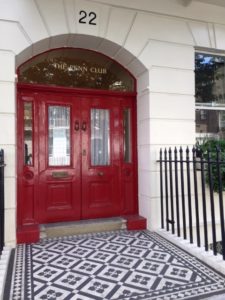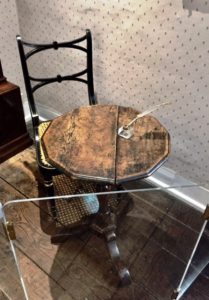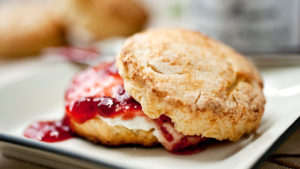Bet I’m one of a small group of people who returned from London and parts of SW England with a sunburn. The first few days of the trip were cool; then temperatures soared into the mid- and upper- 70s—a situation that this land of fog and gray skies doesn’t experience often.
My abode in London was the Penn Club, a well-located spot in Bloomsbury frequented by academics (it’s close to the British Museum) that serves a great breakfast and makes one think Miss Marple is about to pop around a corner. Unless you’re a slave to elegant digs, the place is highly recommended.
Also commendable: the tube. It’s fast, quiet and efficient. Note to New York’s MTA: why not install, as the London tube does, a barrier separating people walking in one direction from those going in the other? It is, as the Brits say, brilliant. And pretty simple. When I think of the melee at Union Square here… well, I try not to.
The trains are also terrific. I bought a Brit Rail Pass before leaving which saves money and time. True, the train returning to London from Hampton Court was delayed due to a switching problem but on all other trips everything worked exactly as it should.
En route to Chawton, Jane Austen’s home, my companion and I hopped off the train in Winchester, walked a short distance to the bus station, got on and went…into the town of Alton having overshot the stop. Blame the bus station that gave us misleading info. Back we went to the correct stop, crossed over the “dual carriageway” and arrived at Chawton where Jane lived her last eight years. Some items in the house are “similar to those Jane would have worn/used/known” but most are the real thing including her (tiny) writing desk;
turquoise and gold ring, muslin shawl she embroidered with itsy-bitsy, beautiful stitches and a stunning quilt she made that’s still in remarkable condition. Any Austen fan (or even a casual reader) would be rewarded by visiting here.
Earlier, as part of my “author’s tour,” was a lovely lunch at Charles Dickens’ London home—he lived here from 1837 to 1839 while writing Oliver Twist, The Pickwick Papers and Nicholas Nickleby.
I found some British food carb-heavy although there are zillions of ethnic restaurants and takeaways that can balance this. High- end food is stylish and much lighter. Pub grub is delicious but of the carby fish-and chips nature. Scones, often eaten with clotted cream and fabulous raspberry jam are TDF and round, not triangular like their American cousins. So…
Proper Scones (say ‘scon’)
2 cups cake flour, more as needed
½ teaspoon salt
2 teaspoons baking powder
3 tablespoons sugar
5 tablespoons cold butter, cut into pieces
1 egg
½ to ¾ cup heavy cream, more for brushing
- Heat the oven to 450 degrees. Put the flour, salt, baking powder and 2 tablespoons of the sugar in a food processor and pulse to combine. Add the butter and pulse until the mixture resembles cornmeal.
- Add the egg and just enough cream to form a slightly sticky dough. If it’s too sticky, add a little flour, but very little; it should still stick a little to your hands.
- Turn the dough onto a lightly floured surface and knead once or twice, then press it into a 3/4-inch-thick circle and cut into 2-inch rounds with a biscuit cutter or glass. Put the rounds on an ungreased baking sheet. Gently reshape the leftover dough and cut again. Brush the top of each scone with a bit of cream and sprinkle with a little of the remaining sugar.
- Bake for 9 to 11 minutes, or until the scones are golden brown.
I like scones so well I could eat one anytime. Brits usually reserve them for afternoon tea, made with leaves not a tea bag. Use a strainer. Pour the milk into your cup first. You don’t take milk? Clearly not British.





and speaking of carbs, there’s always the scone! Love this little tour, Mari, and Jane Austen’s writing desk!
It all sounds delightful.
And who would know better?